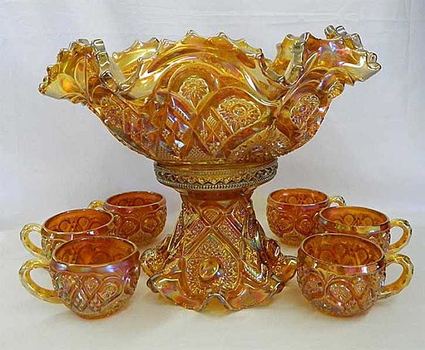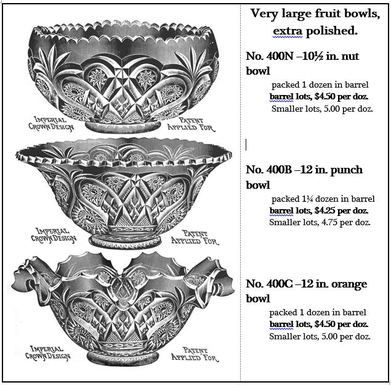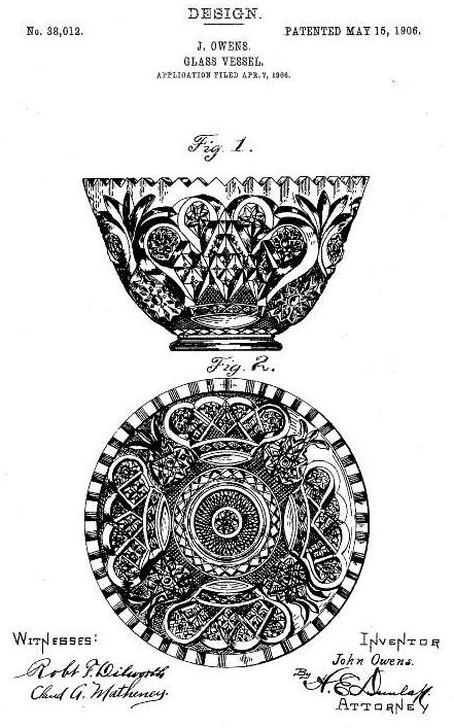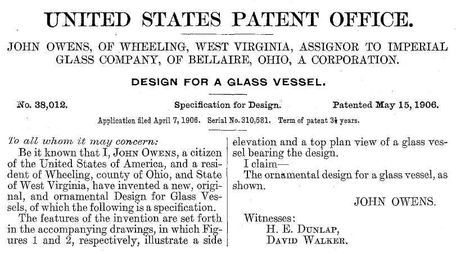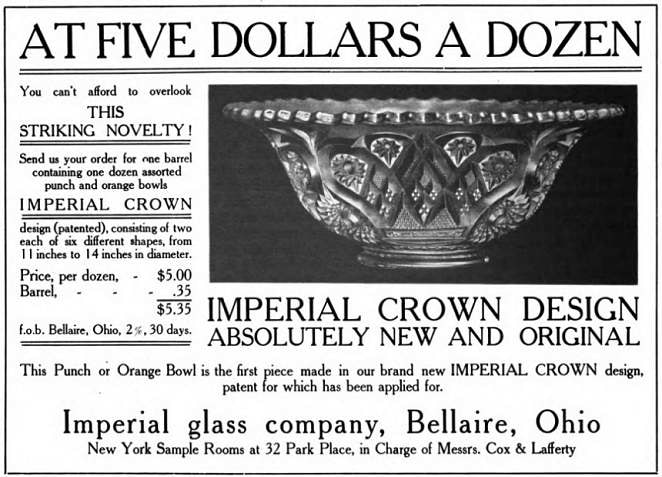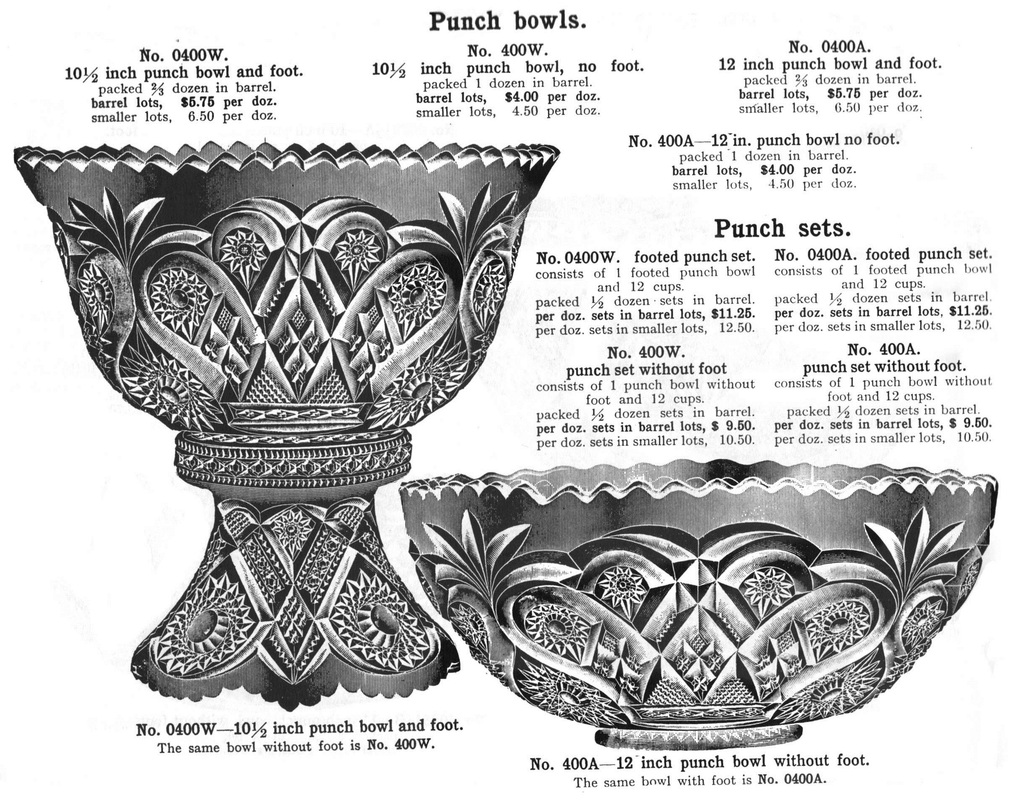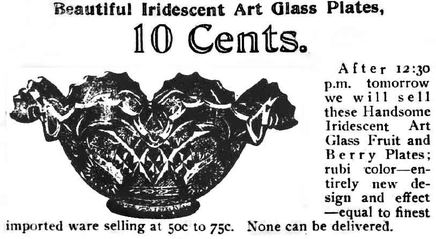Royalty, aka Imperial Crown, aka Imperial #400
Do you recognise the pattern shown here? It’s seldom seen and yet it was introduced (arguably) as a jewel in the crown of Imperial’s intaglio “faux cut” patterns circa 1906. As you can see in the illustrations below (Imperial General Catalog 1909) the pattern was given a name—Imperial Crown Design—and a patent had been applied for it. The pattern was given the name Royalty by Marion Hartung and that is what Carnival Glass collectors know it as today (Rose Presznick called it Queen’s Crown but that name didn’t stick). And now we know the original name given to the pattern by the maker: Imperial Crown.
The Imperial Crown design was initially made in crystal. Here is a quote from the 1906 American Pottery Gazette in an article on the rise of pressed glass: “Of the new designs just come upon the market one of the most striking, because of its richness in decorative effect and exceedingly clever workmanship, is known as the “Imperial Crown” pressed ware, made by the Imperial Glass Company of Bellaire, Ohio. This glass must actually be handled before it is possible to determine that it is really only a piece of pressed ware. It has the sparkle, the life, the brilliancy and almost the sharpness of cut glass”.
Royalty has several "claims to fame"
Firstly, Royalty stands out from Imperial's other geometric patterns: it has a clearly recognisable motif—the crown—which can be easily identified within the pattern. There is no doubt that Imperial had great pride in the design, endowing it with the factory name and adding that information to their catalogue.
In Imperial’s 1909 catalogue there was a very wide range of shapes for their #400 series - Royalty, aka Imperial Crown. There were five different shapes of large fruit bowl (between 10 and 13” in diameter), deep punch bowl and flared punch bowl, 10” orange bowl, 8½” large berry bowl and matching 4½” berry, punch cup, lemonade cup, 8” rose bowl, crimped vase, sugar & cream set, pitcher and tumbler. All these items would have been produced in clear glass. In Carnival Glass, it is only known in a punch bowl (top) and punch cup shapes.
Secondly, it was Patented
Our understanding is that the design was in Imperial’s catalogues from as early as 1904 with the wording “Patent Applied For”, which is one of the truly fascinating aspect of this design. The patent was granted in 1906.
|
Above: the text of the full Patent as applied for and granted in 1906
Left: the 1906 design illustration for the Patent by “Inventor” John Owens, assignor to the Imperial Glass Company Below: an Imperial ad in the 1906 American Pottery Gazette promoting their "patented ... brand new IMPERIAL CROWN design" in crystal glass. |
To the best of our knowledge, Royalty, aka Imperial Crown is one of only a handful of old, Classic Carnival designs that were actually patented. In fact, it might be the earliest example made - another notable example is Harry Northwood’s 1914 Peacock at the Fountain spooner design.
The “inventor” is named as John Owens, “assignor” to the Imperial Glass Co. Our understanding is that he was a factory manager at Imperial, but he clearly had artistic talents too. Did he design any other of the Imperial geometrics? It’s quite possible.
The “inventor” is named as John Owens, “assignor” to the Imperial Glass Co. Our understanding is that he was a factory manager at Imperial, but he clearly had artistic talents too. Did he design any other of the Imperial geometrics? It’s quite possible.
|
The Kent State University website hosts an article about the Carnival makers that states, with regard to Imperial: “Factory managers Thomas Shelley and John Owens were in charge of the organization’s day-to-day operations, and they likely worked with mouldmaker Carl L. Dorer in designing the patterns for the Imperial s initial glassware lines”. It seems that there’s a possibility that Owens designed some of the patterns that Dorer subsequently made the moulds for. Dorer himself is shown as being the inventor of a 1906 patent—for fire polishing and “finishing” glass.
Thirdly, there is no punch bowl base In the list of glass shapes for Royalty there is no mention of a base or stand for the punch bowl. A punch bowl top needs a base, and indeed there was one illustrated in the Imperial catalogue—but it wasn’t in the Royalty pattern. The plot thickens! In fact, no Royalty punch bowl base/stand has ever been found, and there are various “schools of thought” as to what pattern the punch base should be, and indeed some “authorities” state that the correct base is the Long Hobstar one. The illustration on the right reveals the truth … Fashion was the correct base for the Royalty punch set from the very start. So, the picture shown at the top of the page, of a Royalty punch bowl top on a Fashion base is the correct set up, not a mis-match! |
Above: extract from the Imperial 1909 catalogue showing the Royalty punch bowl
matched up with a Fashion base. This is how Imperial intended it to be. |
The following is a quote from the 1906 American Pottery Gazette in an article on the rise of pressed glass.
“Of the new designs just come upon the market one of the most striking, because of its richness in decorative effect and exceedingly clever workmanship, is known as the “Imperial Crown” pressed ware, made by the Imperial Glass Company of Bellaire, Ohio. This glass must actually be handled before it is possible to determine that it is really only a piece of pressed ware. It has the sparkle, the life, the brilliancy and almost the sharpness of cut glass”.
“Of the new designs just come upon the market one of the most striking, because of its richness in decorative effect and exceedingly clever workmanship, is known as the “Imperial Crown” pressed ware, made by the Imperial Glass Company of Bellaire, Ohio. This glass must actually be handled before it is possible to determine that it is really only a piece of pressed ware. It has the sparkle, the life, the brilliancy and almost the sharpness of cut glass”.
|
Initially made in crystal, the Imperial Crown design was named "Royalty" in Carnival Glass by Marion Hartung.
And finally - one more revelation There is one more amazing fact about Royalty. As we first reported exclusively in our monthly NetworK ezine in July 2018, through our research we discovered this ad in the Washington Evening Star in July 1908. This ad is hugely significant in two respects - it is the proof that Imperial was making Carnival Glass in early 1908, and (to date) it is the first known ad for Carnival Glass. Read the full amazing discovery! See more Collectors Facts |
